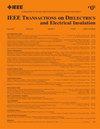基于al2o3的聚乳酸凹抛物面反射器波束倾斜校正的频率捷变MIMO系统
IF 3.1
3区 工程技术
Q2 ENGINEERING, ELECTRICAL & ELECTRONIC
IEEE Transactions on Dielectrics and Electrical Insulation
Pub Date : 2025-01-17
DOI:10.1109/TDEI.2025.3531339
引用次数: 0
摘要
本研究介绍了一种利用聚乳酸(PLA)凹面反射器来提高氧化铝(Al2O3)基频率捷变多输入多输出(MIMO)介质谐振器天线(DRA)系统中天线单元间隔离的新技术。该散热器采用陶瓷材料(Al2O3)设计,相对介电常数($\in $ r)为9.8。频率敏捷性是通过利用介电谐振器(DR)的固有特性来实现的,其中介电谐振器的物理因素定义了谐振频率。基于引脚二极管的t形功率分压器利用其导电和绝缘特性作为馈线。此外,利用聚乳酸的介电特性可以提高元件间的隔离度,提高了24 dB,并可以校正YZ平面上的波束倾斜。这导致天线增益提高约2 dBi,并允许波束倾斜校正高达约40°。它还包括一个射频偏置电路,为射频组件提供绝缘,确保在没有干扰或信号退化的情况下实现最佳性能。通过基于Arduino un系统的实时测试,验证了所提出的通信系统的有效性,确认了其在动态环境条件下的适应性和一致性性能。通过仿真和实验验证了该设计,说明了聚乳酸介质材料在引导电磁波传播和降低耦合效应方面的有效性。DRA和基于介质反射器的隔离相结合使该天线系统成为WLAN和DSRC应用的合适候选者。本文章由计算机程序翻译,如有差异,请以英文原文为准。
Al2O3-Based Frequency-Agile MIMO System With Beam Tilt Correction Using PLA Concave Parabolic Reflector
This study introduces a new technique to enhance isolation among antenna elements in an alumina (Al2O3)-based frequency-agile multiple input multiple output (MIMO) dielectric resonator antenna (DRA) system utilizing a polylactic acid (PLA)-based concave reflector. The proposed radiator is designed from ceramic material (Al2O3) with a relative dielectric constant ( $\in $ r) of 9.8. Frequency agility is attained by utilizing the intrinsic characteristics of the dielectric resonator (DR), wherein its physical factors define the resonant frequency. Pin diode-based T-shaped power divider works as a feedline by utilizing its conductive and insulative property. Furthermore, the dielectric characteristics of PLA are utilized to improve interelement isolation, resulting in a 24 dB enhancement, and to rectify beam tilt in the YZ plane. This results in improving antenna gain by around 2 dBi and allow for a beam tilt correction of up to approximately 40°. It also includes an RF biasing circuit that provides insulation to the RF components, ensuring optimal performance without interference or signal degradation. The efficacy of the proposed communication system is validated through real-time testing using an Arduino UNO-based system, confirming its adaptability and consistent performance across dynamic environmental conditions. The proposed design is validated via simulations and experiments, illustrating the efficacy of the PLA dielectric material in directing electromagnetic wave propagation and reducing coupling effects. The combination of DRA and dielectric reflector-based isolation makes this antenna system a suitable candidate for WLAN and DSRC applications.
求助全文
通过发布文献求助,成功后即可免费获取论文全文。
去求助
来源期刊
CiteScore
6.00
自引率
22.60%
发文量
309
审稿时长
5.2 months
期刊介绍:
Topics that are concerned with dielectric phenomena and measurements, with development and characterization of gaseous, vacuum, liquid and solid electrical insulating materials and systems; and with utilization of these materials in circuits and systems under condition of use.

 求助内容:
求助内容: 应助结果提醒方式:
应助结果提醒方式:


